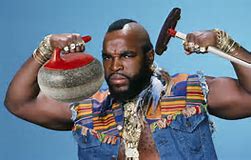Canadians love it. So do the Scandinavian countries. But when the one and only Mr. T declares that the sport of curling is cool, that may just be what this unique Winter Olympic sport needs to slide more into favor in the United States!
Well, it might take a little more time. As South Korea’s Winter Olympics have taken over America’s sports television landscape after the NFL season has ended, I am enjoying many of these cold weather sports, but none as much as the fascinating sport of curling.
Yes, that odd indoor sport where both men and women compete sliding “stones” down a sheet of ice into a target area of concentric circles. Some call the sport of curling, “Chess on Ice.” Not me. Curling seems to be a relatively simple game, but it is one which requires a lot of strategies you might find in other sports, too.
In the Winter Olympics, each nation’s curling team is comprised of four players. Each player gets two chances apiece to slide their 40-pound granite curling stone (also called a “rock” or even the colorful term, “pancake“) toward the target area (also known as the “house”). There is no scoring until the final team’s final stone has completed its journey down the ice. At that time, the team with the closest stone(s) to the center wins one or more points for that session. That’s it – for the first game.
Curling is also a bit like a baseball game. Instead of a nine-inning game, each curling set is called an “end”. There are ten “ends” in a match. When you’re watching on TV and see “End 5”, it’s not necessarily the bottom of the fifth, but simply the 5th frame (a little bit like bowling!).
Like golf, each “end” features the team who scored the most recent point going first to start the next “end”. In that manner, the trailing team will get to take the all-important final shot (which is called the “hammer”) for that frame.
Different than golf, though, there is a shot clock. The Olympic curling team’s clock starts running once the other team’s stone has come to a halt, and the team clock stops again when you or your teammate has released the next stone down the icy lane. For a ten “end” game, each team receives a total of 73 minutes of clock time during the match to size-up (as in billiards) the most effective strategy to execute the next shot. You rarely see teams dawdle in curling.
Like auto racing, you have the option of jumping ahead early in the “end” by going on the offensive to get stones into the colorful “house”. Your team can also opt to slyly lay in wait until the final few stones before charging from behind to dislodge your opponent’s rocks from the center scoring zones and replacing them with your own.
Your team’s best player is known as “skip” (as in skipper). He or she gets the privilege of getting the final two shots in each “end”.
Just like basketball, curling matches may occasionally feature a “circus shot” where a flashy, low-percentage shot may be attempted. Sometimes, you just gotta take a chance if you want to win!
In addition to sliding that big round piece of granite toward an icy target, the other members of your team get a chance to have some fun while they await their turn. In curling, you can impact the final destination of that heavy rock by using a “broom” (yes, a special curling broom) to quickly shave the ice down just ahead of the approaching stone. Your team’s “sweepers” can help a stone to either slow down at the desired location or help it go a little further, too.
Finally, curling (which dates back to the 1500’s in Scotland) has a long history of friendly competition and sportsmanship. Like golf, the players are expected to call fouls upon themselves (example – if one of your “sweepers” accidentally touches the approaching stone or a stationary stone along the path). This sport highly discourages the making distracting noises or taunting of your opponents (unlike this fellow: https://www.youtube.com/watch?v=A8yjNbcKkNY).
In fact, it is common to see some teams graciously concede defeat prior to the end of a 10-end match if one team falls too far behind. The curling tradition also involves sharing a beverage in a local pub with your opponents after a match. Name another Olympic sport which actually encourages that!
So, enjoy your hockey, snowboarding, downhill racing, and all of the other Winter Olympic sports for the next few weeks.
Mr. T and I will be watching the curling. I pity the fool who doesn’t learn to like it!

